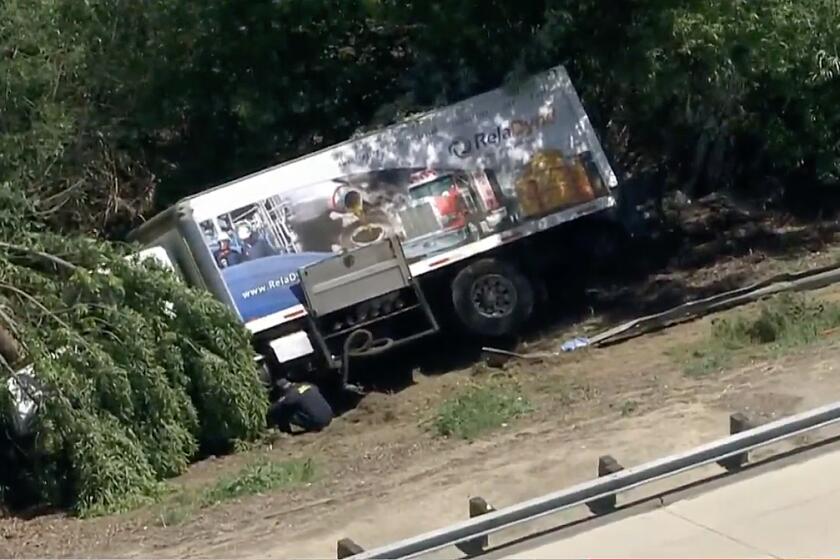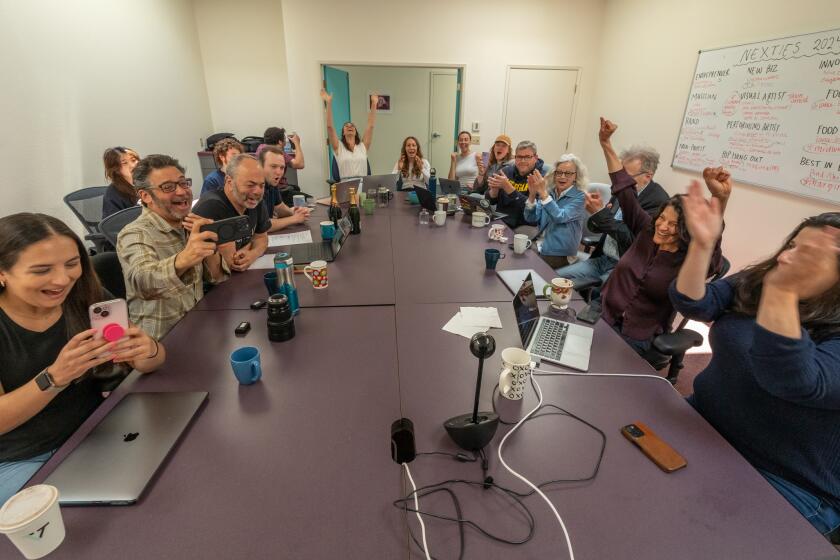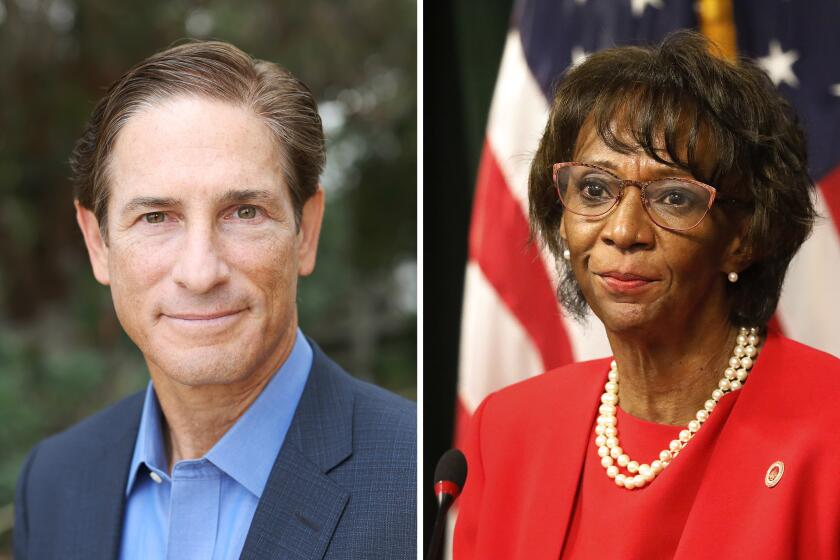Boys’ Slayings Show Pasadena’s Other Side : Cities: Shootings half a mile from the Rose Parade route shocked those who see it only as home of Norton Simon Museum and Caltech. But observers say it is two cities: One rich, one poor.
Mention the poverty and gang violence just blocks away from the Rose Parade’s route through downtown Pasadena and outsiders shake their heads in disbelief.
“Without fail, there’s a body language, a little gasp and the remark, ‘I didn’t know that,’ ” says Vice Mayor Kathryn Nack.
For most out-of-towners, Pasadena is a city of civilized hoopla, whether it’s the flowery extravaganza viewed each New Year’s Day by a worldwide television audience, a football game at the Rose Bowl or dinner and a movie in Old Pasadena, the refurbished warehouse district on Colorado Boulevard.
But sometimes, horrible events make the point: Pasadena is a city with a menacing side.
Such was the case on Halloween night, when a group of teen-agers returning from a party and a trick-or-treat excursion walked into an ambush on North Wilson Avenue, half a mile from the parade route. Three boys, ages 13 and 14, were left dead on the sidewalk, bags of candy scattered around them.
The killings, by gunmen who reportedly laughed as they fled in cars, have left residents groping for explanations.
Pasadena is a city of striking contrasts--”a tale of two cities,” Pasadena Urban League President Shirley Adams said. “One rich, one poor. One employed, one unemployed.”
A few blocks from the mansions in the hills and along the avenues at the west end of the city sits northwest Pasadena, where almost a third of the population lives below the poverty level.
It is a racially diverse neighborhood, with a core of hard-working homeowners and apartment dwellers, including a contingent of young urban professionals living in some of the area’s Craftsman bungalows.
But the neighborhood can be a violent, troubling place--foreign territory for most of the city’s wealthy and middle class.
The Halloween killings, which occurred a few blocks east of northwest Pasadena and was attributed to gang members, shows that “we’re in the middle of a gang war,” said Prentice Deadrick, who manages municipal programs for the northwest district.
According to one popular scenario, the victims, who had no gang affiliations, were either mistaken for others or were targeted because they lived near gang members. Some residents say the killings--which occurred in a neighborhood a few blocks outside northwest Pasadena--may have been an act of retaliation for a shooting that occurred earlier that evening half a mile away.
There have been 24 homicides in the city this year--already surpassing last year’s total of 18--and at least 10 of them have been gang-related, police say.
The rate of murder, compared to the population, is still far behind Los Angeles, but it is troubling to people like Deadrick.
“Pasadena is in a state of denial” about burgeoning gang problems in its northwest neighborhood, he said. The denial, Deadrick said, grows out of a desire to present an image of serenity.
“There’s a fear that people won’t flock to the city by the millions New Year’s Eve and sleep on the pavement (awaiting the Rose Parade) if they have any idea that there are gang marauders out there,” he said.
*
The mix of haves and have-nots in Pasadena has created tensions in the past.
After the Simi Valley trial last year of four police officers charged with beating Rodney G. King, youths swarmed through Old Pasadena, smashing windows and committing random assaults.
At least three victims, all white, were shot in Pasadena’s rioting, and arsonists torched a seven-store shopping center.
Hostilities have spilled over into the city’s civic life, too. Demonstrators have targeted the Tournament of Roses in protest over the organization’s all-white-male leadership, promising to “shut down the parade” Jan. 1. Pasadena’s City Council chambers have been the scene of open hostilities between Isaac Richard, the northwest’s volatile council representative, and his colleagues, often over race-related issues.
But Pasadena is no different from other cities, city officials say, except that it’s a little more compact and news travels a little faster.
“There’s no more of a contrast than there is between Bel-Air and Watts,” Mayor Rick Cole said. “But in our city, (the equivalents of) Bel-Air and Watts are within a stone’s throw of each other.”
It’s a city of 132,000, draped across the western San Gabriel Valley like a bib, with a pair of drawstrings--Eaton Canyon and the Arroyo Seco--stretching northward into the San Gabriel Mountains.
*
For generations, Pasadenans have prided themselves on the city’s gentility. The boast is that residents can be cultured and educated without crossing the city limits.
The Norton Simon Museum of Art with its Degas sculptures, the Ambassador Auditorium with its piano virtuosos and chamber orchestras, Caltech with its Nobel Prize-winning scientists and the Pacific Asia Museum with its Chinese and Japanese antiques--are part of an unusually sophisticated cultural scene.
The miraculous transformation of the city’s warehouse district on Colorado Boulevard into one of Southern California’s prime entertainment districts has also helped put it on the map.
Old Pasadena, a national model of urban renewal, draws about 15,000 well-heeled people on Friday and Saturday evenings. Visitors meander through high-tech billiard parlors and world-class Italian restaurants, pausing to listen to a sidewalk steel drummer or line up for a movie. There are more than 60 restaurants along the neighborhood’s streets and alleys.
Even local merchants look at the crowds with astonishment. “I don’t think anyone planned on the area being as successful as it is,” said Jack Smith, president of the Old Pasadena Business and Professional Assn.
Meanwhile, a couple of miles to the north, young men stand on street corners, passing around liquor bottles and drug paraphernalia.
“When I moved here 30 years ago from Shreveport, La., you hardly ever heard a siren,” said the Rev. William Turner, pastor of New Revelation Baptist Church in Pasadena’s predominantly black and Latino northwest neighborhood. “There were three or four liquor stores.”
Now, almost half of the city’s 98 liquor stores are concentrated in the northwest, where about 35% of population lives, and the sirens are a frequent, unsettling presence.
With the disappearance of entry-level jobs, the introduction of drugs and easy access to alcohol, Turner said, Pasadena has produced a generation of young people with little hope.
“The attitude is, ‘We might as well end the future in the present,’ ” Turner said.
The unemployment rate in the northwest district is significantly higher than the rest of the city, and 45% of the adults in the area do not have high school diplomas. Per capita income, $9,210, is less than half that of the city as a whole. Comparisons with adjoining census tracts are even more dramatic. The median household income in one palmy hillside neighborhood across the Arroyo Seco is more than $69,000 higher than that of an adjacent neighborhood in the northwest.
Social workers who deal with gangs estimate that there are about 2,000 gang members in Pasadena and Altadena, most of them concentrated in the northwest. A USC study this year, which surveyed more than 1,600 Pasadena young people, found that 60% of high school-age students knew someone who has been killed or injured in gang activity, and 20% of high school juniors and seniors said they had been shot at.
Longtime residents say the Foothill Freeway, whose builders leveled a thriving African-American commercial center in the early 1970s, serves as a kind of symbolic barrier between the two Pasadenas.
With the arrival in recent years of thousands of Latino and Asian immigrants, the city has become a “majority-minority” city. The last census showed 53% of the population are people of color. Most of the blacks and Latinos making up the new majority are packed into the northwest.
Like the rest of the city, the northwest has begun to look more diversified, with a population that is now 45% Latino, 35% black and 15% white. But for longtime Pasadenans familiar with the history of troubled race relations in the city, the freeway serves as a metaphor for the racial divisiveness best exemplified by the northwest’s history of neglect.
“In many ways (the freeway) represents Pasadena’s apartheid wall,” said Tim Brick, a member of the city’s Utility Advisory Commission. “The problems north of the freeway haven’t mattered to the rest of the city.”
Nobody is offering the excuses of poverty or racism for the Halloween murders. People from all over Pasadena said last week that the death of the three teen-agers, youngsters without gang ties who were engaging in wholesome activities, reached a new level of coldbloodedness.
“A line has been crossed,” Vice Mayor Nack said.
The murders of Stephen Coats and Reggie Crawford, both 14, and Edgar Evans, 13, have galvanized much of the city, with church leaders planning interdenominational prayer services and civic leaders talking of pressing for gun controls. Sunday was declared a day of mourning in Pasadena, with houses of worship memorializing the deaths with moments of silence.
Last week, the City Council approved a $25,000 reward for information on the boys’ murderers, a fund that has swelled to $40,000 with contributions from the Los Angeles County Board of Supervisors and the Stop the Violence, Increase the Peace Foundation.
There has always been a sense of social obligation in Pasadena, city officials say. This is a city that has adopted a holistic strategy of administering human services, with building inspectors and tree-pruners encouraged to get involved in social problems. Police officers in Pasadena are trained to be proactive, approaching crime as a problem with social causes, rather than just filling the city jail with suspects.
Two years ago, the City Council established northwest Pasadena as one its top priorities, pledging to restore the neighborhood’s infrastructure--streets, sidewalks, parks--and upgrade city services.
But then, like cities all over Southern California, it stumbled into a budget crisis.
Richard--who often plays the role of the northwest’s avenging angel at council meetings, blasting his colleagues as racists--contends that, so far, the efforts have been a joke. More attention has been devoted to such projects as restoring the Colorado Street Bridge, a city landmark, and building the Rose Bowl Aquatic Center, Richard says.
“The city spends $6 million on an Olympic aquatic center when there’s an infant mortality rate higher than Malaysia’s,” Richard said scornfully. (The infant mortality rate among black Pasadenans in 1991 was 26.1 per 1,000, which is slightly higher than that of Malaysia.)
But the sense of commitment from the city and from many of its citizens has made a difference in the past, northwest community leaders say.
Take last year’s civil disturbances. Pasadena escaped widespread arson and looting largely because adults patrolling the northwest neighborhood defused much of the rage.
Community leaders and concerned parents, mobilized into roving patrols by We CARE, confronted bands of youths and encouraged them to go home while social service storefront agencies and a city-owned cable television station offered information and squelched rumors.
*
As Adams of the Urban League described it, the effort was highly personalized. “In one case, a community member saw a teen-ager out there,” Adams said. “She said, ‘Don’t you know me? I’m so-and-so’s mother. You’ve been to my house. Go home.’ ”
It may take that kind of approach, with family members and community leaders exerting moral pressure and employers offering jobs, to defuse gang tensions, community leaders say. Without such an effort, they say, the prospects are for more violence.
“I hate to forecast doom,” said Alan La Sha, a co-chairman of We CARE. “But the two Pasadenas are going to collide someday. It’s going to be explosive.”
More to Read
Start your day right
Sign up for Essential California for news, features and recommendations from the L.A. Times and beyond in your inbox six days a week.
You may occasionally receive promotional content from the Los Angeles Times.






